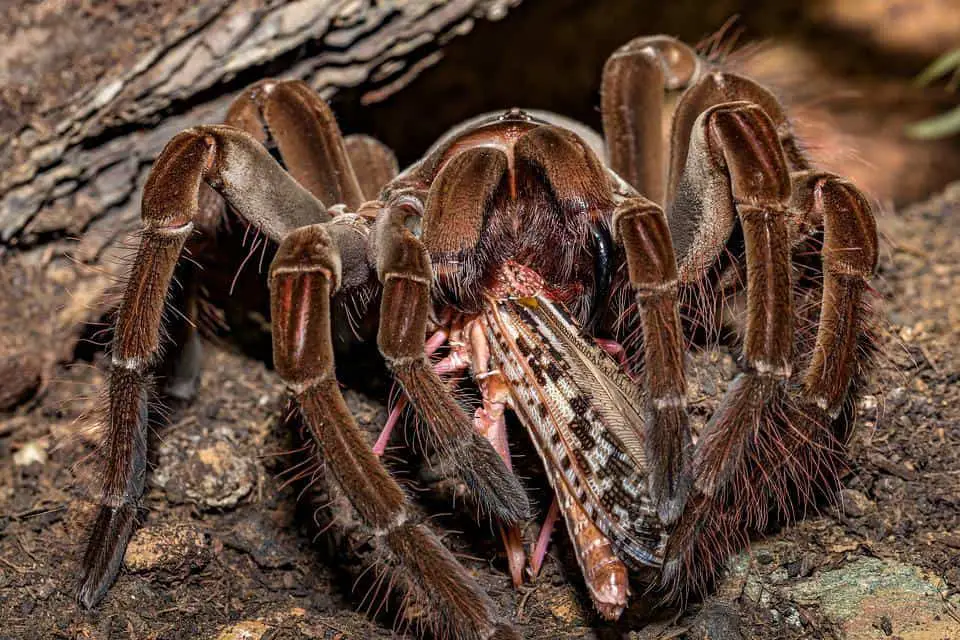Tarantulas are the largest spiders in the world. To sustain their large size, they feed exclusively on meat, which means that they are carnivores. In the wild, they feed primarily on insects, but they will also eat a variety of small lizards, mammals, and sometimes even birds!
The types of foods that tarantulas can eat are highly dependent on their size. Dwarf tarantulas are very small and thus incapable of taking down larger prey. However, larger species are easily capable of overpowering larger prey.
To learn more about why these beautiful spiders are classified as carnivores, keep reading. We will also discuss whether tarantulas are cannibals.
Are tarantulas omnivores?
Tarantulas are not omnivores. Omnivores eat a combination of plants and meat. Tarantulas only eat meat, so they are by definition not omnivores.
However, while tarantulas are not omnivores, there are 95 other spider species that are omnivorous! These spiders eat a variety of different fruits, plants, and nectars in combination with insects.
Are tarantulas herbivores?
Being a herbivore means that you only eat plants.
Tarantulas never eat plants, as such, they are definitely not herbivores. If you try putting some fruit or a vegetable in your tarantula’s enclosure they will simply ignore it because they do not recognize it as food. They cannot digest it and can not derive any nutrients from eating plants.
In fact, while there are over 45,000 spider species, only one of them is known to be herbivorous, and that is the Bagheera kiplingi, which is a jumping spider species.
Are tarantulas carnivores?

Yes, tarantulas are indeed carnivores. To be more precise, they are obligate carnivores, which means that they depend solely on meat or insects for their survival.
The tarantula’s primary source of food is a wide variety of different insects.
They’ll eat pretty much insect that walks near their burrow as long as it’s small enough for them to overpower. The insects they eat most often include crickets, grasshoppers, roaches, many different worms, and caterpillars. Arboreal tarantulas also often eat flying insects such as dragonflies or moths.
But that’s not all they eat. Large tarantula species such as the Goliath Birdeater or Salmon Pink Birdeater are large enough to be able to take down mice and other small rodents as well as small lizards such as geckos.
In addition, as their name suggests, they will also eat birds if they have a chance to. Of course, since birds can fly, they’re much more difficult to ambush.
Are tarantulas cannibals?
There are over 800 tarantula species currently identified, and many of them do indeed practice cannibalism. Females especially are often cannibals because they frequently eat the males after mating, they do this because eating the male gives them nutrients that make it more likely for them to give birth successfully.
In addition, tarantulas often become cannibalistic when there’s not enough space for both of them. In the wild, this can happen when there are territorial disputes and one tarantula enters another’s burrow, which will result in a fight. After which, the winner will eat the loser.
In captivity, it can also happen when hobbyists house more than one tarantula in the same enclosure. However, there are exceptions to this rule.
Some species, such as the Socotra Blue Baboon are capable of communal living. This means that multiple of these spiders can live in the same enclosure without them becoming aggressive towards one another.
How do tarantulas hunt their prey?
Tarantulas are ambush predators. This means that they create a place to hide, this can be a burrow for terrestrial species or a hole in a tree for arboreal species, where they wait.
They will create a web in front of the burrow that acts like a tripwire, alerting the spider that prey is nearby.
Once the tripwire notifies them that prey is nearby, they can run out of their hiding place at explosive speed due to the fact that they use a special liquid to move their legs.
Then, they use their sharp fangs to puncture the skin or exoskeleton of their prey and inject their venom. Their venom then kills the prey and liquefies their inside.
Once the prey’s insides are liquified, they use their pedipalps to put the prey into their sucking stomach to slurp out the liquefied insides.
What’s interesting is that tarantulas do not need to eat very often. In fact, right after they’ve consumed a large amount of food they can go for months without eating as long as they’re able to drink water from time to time.
The reason why they can do this is that they barely move. Because they move so little, they do not expend a whole lot of energy, which is why they can go for extremely long periods without food. On top of that, they’re cold-blooded, which means that they do not need to use energy to keep their body temperature up.
If you’d like to see a how tarantulas hunt the meat they eat, here’s a great one from National Geographic
Final words
Tarantulas are obligate carnivores that depend solely on insects and meat for their survival. Plants, fruits, and other sources of food do not register as edible to them because they cannot digest them. As a result, meat is the only thing that is nutritious to them and the only thing that they should eat.
- How Long Do American Eskimo Dogs Live? Important Factors and Care Tips - September 29, 2023
- Do American Bulldogs Need Grooming? Essential Tips and Care Guidelines - September 29, 2023
- Do Bengal Cats Enjoy Playing? Essential Tips for Keeping Them Active - September 29, 2023